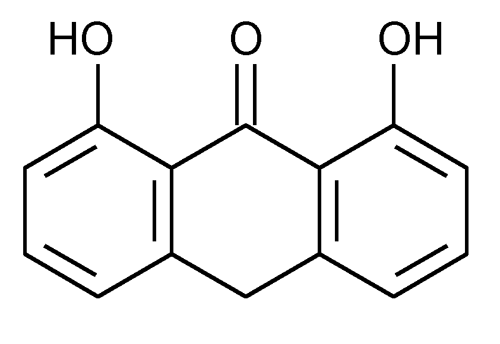Anthralin
» Anthralin contains not less than 97.0 percent and not more than 102.0 percent of C14H10O3, calculated on the dried basis.
Packaging and storage—
Preserve in tight containers in a cool place. Protect from light.
Identification—
Acidity or alkalinity—
Suspend it in water, and filter: the filtrate is neutral to litmus.
Loss on drying  731
731 —
Dry it over silica gel for 4 hours: it loses not more than 0.5% of its weight.
—
Dry it over silica gel for 4 hours: it loses not more than 0.5% of its weight.
Residue on ignition  281
281 :
not more than 0.1%.
:
not more than 0.1%.
Chloride  221
221 —
Add 1 g of it to 15 mL of water, mix, and filter. Acidify 5 mL of the filtrate with nitric acid, and add a few drops of silver nitrate TS: no more opalescence is produced immediately than is present in a 5-mL portion of the filtrate to which nothing has been added.
—
Add 1 g of it to 15 mL of water, mix, and filter. Acidify 5 mL of the filtrate with nitric acid, and add a few drops of silver nitrate TS: no more opalescence is produced immediately than is present in a 5-mL portion of the filtrate to which nothing has been added.
Sulfate  221
221 —
To 5 mL of the untreated filtrate obtained in the test for Chloride add 3 drops of 3 N hydrochloric acid and 5 drops of barium chloride TS: no more turbidity is produced than is present in a 5-mL portion of the filtrate to which nothing has been added.
—
To 5 mL of the untreated filtrate obtained in the test for Chloride add 3 drops of 3 N hydrochloric acid and 5 drops of barium chloride TS: no more turbidity is produced than is present in a 5-mL portion of the filtrate to which nothing has been added.
Assay—
[note—Use low-actinic glassware.]
Internal standard solution—
Dissolve a sufficient quantity of o-nitroaniline in a small quantity of dichloromethane, and dilute with n-hexane to obtain a solution having a concentration of about 500 µg per mL.
Mobile phase—
Prepare a degassed mixture of n-hexane, dichloromethane, and glacial acetic acid (82:12:6). Make adjustments if necessary (see System Suitability under Chromatography  621
621 ).
).
System suitability preparation—
Prepare a solution containing 0.1 mg of USP Anthralin RS and 0.2 mg of danthron per mL in dichloromethane. Transfer 5 mL of this solution to a 25-mL volumetric flask. Add 5.0 mL of n-hexane, dilute with Mobile phase to volume, and mix.
Solvent blank solution—
Mix Mobile phase, n-hexane, and dichloromethane (3:1:1).
Standard preparation—
Dissolve an accurately weighed quantity of USP Anthralin RS in dichloromethane to obtain a solution having a known concentration of about 250 µg per mL. Pipet 5 mL of this solution and 5 mL of Internal standard solution into a 25-mL volumetric flask, dilute with Mobile phase to volume, and mix.
Assay preparation—
Weigh accurately about 250 mg of Anthralin into a tared 100-mL flask, dilute with dichloromethane to volume after dissolution of the solid, and mix. Pipet 10 mL of the solution into a 100-mL volumetric flask, dilute with dichloromethane to volume, and mix. Pipet 5 mL of this solution and 5 mL of Internal standard solution into a 25-mL volumetric flask, dilute with Mobile phase to volume, and mix.
Chromatographic system
(see Chromatography  621
621 )—The liquid chromatograph is equipped with a 354-nm detector and a 4.6-mm × 25-cm column that contains packing L3. The flow rate is about 2 mL per minute. Chromatograph replicate injections of the Standard preparation, and record the peak responses as directed for Procedure: relative retention times are 1.0 for anthralin, about 1.2 for danthron (if present), about 1.7 for dianthrone (if present), and about 2.3 for o-nitroaniline; and the relative standard deviation of the ratio of the peak responses is not more than 2.0%. Chromatograph the System suitability preparation: the resolution, R, is not less than 1.3; and the tailing factor, T, is not more than 1.5. Chromatograph the Solvent blank solution: no effect on the baseline is discernible at the retention time of anthralin.
)—The liquid chromatograph is equipped with a 354-nm detector and a 4.6-mm × 25-cm column that contains packing L3. The flow rate is about 2 mL per minute. Chromatograph replicate injections of the Standard preparation, and record the peak responses as directed for Procedure: relative retention times are 1.0 for anthralin, about 1.2 for danthron (if present), about 1.7 for dianthrone (if present), and about 2.3 for o-nitroaniline; and the relative standard deviation of the ratio of the peak responses is not more than 2.0%. Chromatograph the System suitability preparation: the resolution, R, is not less than 1.3; and the tailing factor, T, is not more than 1.5. Chromatograph the Solvent blank solution: no effect on the baseline is discernible at the retention time of anthralin.
Procedure—
Separately inject equal volumes (about 10 µL) of the Standard preparation and the Assay preparation into the chromatograph, record the chromatograms, and measure the areas for the major peaks. Calculate the quantity, in mg, of C14H10O3 in the portion of Anthralin taken by the formula:
C(RU / RS)
in which C is the concentration, in µg per mL, of USP Anthralin RS in the Standard preparation; and RU and RS are the response ratios of the anthralin peak to the o-nitroaniline peak obtained from the Assay preparation and the Standard preparation, respectively.
Auxiliary Information—
Please check for your question in the FAQs before contacting USP.
Chromatographic Column—
| Topic/Question | Contact | Expert Committee |
| Monograph | Feiwen Mao, M.S.
Scientist 1-301-816-8320 |
(MDOOD05) Monograph Development-Ophthalmics Oncologics and Dermatologicals |
| Reference Standards | Lili Wang, Technical Services Scientist 1-301-816-8129 RSTech@usp.org |
USP32–NF27 Page 1560
Chromatographic columns text is not derived from, and not part of, USP 32 or NF 27.
